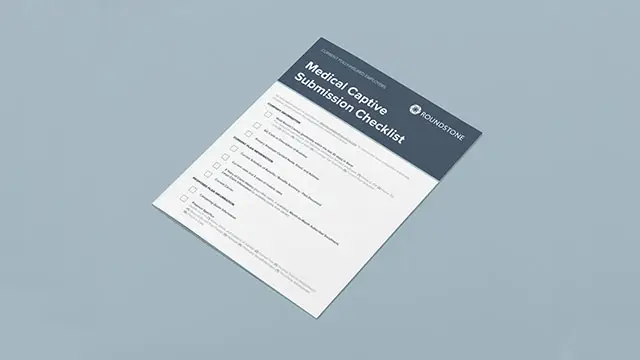- Employers
- Advisors
ADVISORS
Roundstone recognizes and appreciates the important role benefits advisors play — that’s why we only operate through our network of trusted advisors.
- Resources
THE LATEST AND THE GREATEST
- Blog
BLOG
Stay up-to-date with the latest trends and learn about how small to midsize businesses can enjoy the benefits of self funded health insurance.
LATEST POST
FEATURED FAVORITES
- About Us
ABOUT US
We are a health benefits captive providing self-funded solutions to small and mid-sized employers. Our self-funded medical group captive bands employers together to fund their benefits the way much larger Fortune 500 companies do.
- Our TPA
Find this article helpful? Share it with others.

What Is Self-Funded Healthcare and Why Does Budgeting Matter?

Self-funded insurance means you—as opposed to a traditional carrier—take control of your healthcare spend. Instead of paying fixed premiums, you fund employee claims directly and only pay for what’s used. That control unlocks big savings potential—but only if you budget wisely.
With a sound budget, your self-funded health plan becomes a predictable, sustainable part of your business instead of a financial wildcard.
Why? Because self-funded plans save employers up to 20% annually compared to fully insured plans.
Self-funding vs Level Funding vs Fully Insured Plans
If you’ve started exploring alternatives to traditional insurance, you’ve probably come across level-funded plans. These are often marketed as a safer or simpler version of self-funding—but the differences matter.
Not all self-funding models are created equal, and understanding how level-funding compares to fully insured and group captive solutions can help you make the most informed budgeting decision.
A level-funded plan sets a fixed monthly payment based on expected claims. If claims run high, stop-loss insurance kicks in. If claims run low, you might get a small refund—but the carrier keeps most of the savings, and claims data access is often limited.
On the other hand, a self-funded group captive gives you:
- Full control of your plan design
- Real-time access to your claims data
- A pro-rata share of any unspent captive premiums
- Lower fixed costs and greater long-term savings
Level-funding may be a step in the right direction—but a group captive is the destination.
How a Group Captive Plan Helps You Budget for Healthcare
A group captive pools many small and midsize employers together, giving you the scale and stability of a large corporation—without giving up flexibility. You fund only what you use and share risk for larger claims through a captive pool protected by stop-loss insurance.
With Roundstone, you also get something unique: a return of unspent premiums. To date, Roundstone has returned $91.8 million to its captive members—money that would’ve gone to a traditional carrier’s bottom line.
Join Our Newsletter
Sign up for fresh insights straight to your inbox.
Key Budgeting Strategies for a Self-Funded Plan
Self-funded plans are flexible—but flexibility requires planning. Here’s what every employer should include in their budgeting playbook:
- Plan for the unexpected. Claims may fluctuate. Build a small surplus in Year 1 to cushion early surprises.
- Understand your fixed vs. variable costs. Fixed costs include stop-loss premiums and admin fees. Variable costs are employee claims.
- Use your claims data. Roundstone Reporting gives real-time access to claims trends so you can proactively adjust.
- Choose the right partners. Your third-party administrator (TPA) and pharmacy benefits manager (PBM) play a direct role in claims processing and prescription costs. Roundstone works with Bywater, our in-house TPA, for its transparency and service model. We also recommend transparent or pass-through PBMs that return 100% of rebates and pricing advantages to the employer.
What Are the Self-Funding Payment Models?
You can choose from several funding options depending on your risk tolerance and cash flow preferences:
- Pay as you go. Pay claims as they happen. Best for strong cash flow.
- Funding to expected. Fund to projected claims. Stop-loss covers the rest.
- Funding to max: Build in a buffer. If claims exceed expectations, you’re still covered.
Roundstone offers flexible funding options—your advisor will help you choose the best fit.
Escrow Accounts, Surplus Funds, and Stabilizing Costs
Maintaining an escrow account ensures smooth claims processing and financial transparency. Many employers also create a surplus fund to guard against volatility in the first year.
If actual claims come in below projections—as they often do—that surplus becomes a powerful asset. Most companies use it to:
- Stabilize employee cost sharing
- Offset future claims
- Invest in wellness programs
How Stop-Loss Insurance and Deductibles Work
Stop-loss insurance protects your plan from catastrophic costs. You choose a specific deductible (per claim) and an aggregate deductible (per year). These are based on your group size.
- Small group (30–50 employees): ~$20,000–$30,000 deductible
- Larger group (200+ employees): $150,000–$200,000 deductible
With Roundstone, you’re never alone in these decisions—our team of underwriters and advisors helps you select the best deductible strategy for your risk profile.
Deductibles scale with group size, but you never face large claims alone. That’s what stop-loss insurance is for.
What Sets Roundstone Apart?
Roundstone doesn’t profit from your health plan—you do. Here’s how:
- We charge a flat captive management fee, clearly disclosed.
- 100% of unused premiums are returned to employers.
- We negotiate aggressively on your behalf for stop-loss and reinsurance rates.
- Our in-house underwriters and advisors support your plan from day one.
At Roundstone, our incentives are aligned with yours—because your savings are our success.
Roundstone gives you the tools, transparency, and support to make self-funding work. With proactive budgeting and the right cost-containment strategy, your healthcare plan becomes an asset—not a liability.

For everything you need to know about budgeting for self-funding, watch our webinar series on demand.
Roundstone on Roundstone: Our Own Self-Funded Success
At Roundstone, we walk the walk. We moved to our own self-funded group captive plan more than eight years ago.
“Since joining our own self-funded group captive, we’ve saved over $1.1 million and returned more than $224,000 in surplus. Our employees haven’t had a premium increase in 8 years—clear proof the model works.” - Mike Schroeder, Founder & President, Roundstone
We used surplus funds to enhance our plan, introduce a wellness program, and cover more services—all without passing rising costs onto our team.
The self-funding model works. We’ve seen it firsthand.
Find Out How Much You Can Save With Roundstone
Curious what a self-funded group captive plan could save your business? Use our interactive Cost Savings Calculator to get a personalized estimate based on your company’s size, current spend, and plan design.
In just a few clicks, you’ll see how much you could save annually—and how much unused premium you could get back. It’s quick, easy, and built to help you make smarter budgeting decisions.
Ready to Take Control of Your Healthcare Budget?
Want to explore how a self-funded group captive plan can lower your healthcare costs while improving care? Let’s talk!
We’ll help you build a smarter, more affordable benefits plan—with transparency and support every step of the way.
Still have questions? See our Frequently Asked Questions below for answers to the most common questions about budgeting for a self-funded health plan.
Frequently Asked Questions
Self‑funded health insurance (also known as self‑insured) means the employer pays for employee medical claims directly from its own funds rather than purchasing a fully insured plan. Employers typically partner with a third‑party administrator (TPA) to process claims and manage administrative duties.
A group medical captive is a risk-sharing model where similar employers pool premiums into a captive fund that covers claims beyond each employer’s specific deductible. Any unused premium is returned to members annually, and catastrophic claims are covered via stop‑loss reinsurance.
Group captive insurance is typically best for companies with 25 to 1,000 employees, seeking control over plan design, transparency into claims data, and potential savings of up to 20%. Suitable employers also value long‑term strategies and risk sharing rather than one-size-fits-all fully insured plans.
Common funding models include “Pay As You Go” where claims are paid as they occur, “Funding to Expected” based on projected claim costs, and “Funding to Max” which includes a built-in buffer plus stop‑loss coverage. Employers choose based on cash flow preferences and financial risk tolerance.
Stop‑loss insurance protects self‑funded employers by covering claims beyond a specified individual or aggregate deductible, safeguarding against catastrophic losses. These policies effectively limit financial risk in self‑insurance arrangements.
Many employers save 10–20% annually compared to fully insured premiums through reduced administration costs, better cash flow, and retention of unused risk funds. Those savings stem from paying only actual claims costs and capturing surplus through captive mechanisms.
Self‑funded health plans are regulated under ERISA and federal laws like HIPAA, COBRA, and the ACA, but are exempt from most state insurance mandates. This affords flexibility in plan design while still requiring compliance with federal standards.
Yes. Thanks to group captives and stop‑loss insurance options, businesses with as few as 25–50 employees can now self‑insure and share risk affordably—gaining benefits once limited to large employers.
A TPA administers daily operations of a self‑funded plan—handling claim processing, reporting, regulatory filings, and member services—while the employer retains financial responsibility for claims. Employers can select a TPA aligned with their data and service needs.
Many employers budget conservatively in Year 1 to build a surplus that cushions against unexpected high claims and volatility. That surplus also stabilizes future contribution rates and provides flexibility in plan design.
Funding to Expected means you set your budget based on projected claim costs using actuarial data, with stop-loss insurance protecting you from overages. Funding to Max builds in a higher contribution upfront to cover worst-case claim scenarios and offers maximum predictability—similar to the fully insured experience but with the savings potential of self-funding.
ABOUT THE AUTHOR

Roundstone Team
Enjoy Reading?
Check out these similar posts.


How to Use PEPY as a Benchmark to Contain Healthcare Costs

Specialty Prescription Drugs: Advanced Cost Containment Strategies
Roundstone Insurance © 2025








